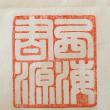
Uncle Tom's Cabin (布面精装)(现货,实拍书影)
¥ 85 九五品
仅1件
送至北京市朝阳区
运费快递 ¥10.00
作者Harriet Beecher Stowe
出版社Everyman's Library
ISBN9780679443650
出版时间1995-04
装帧精装
页数536页
货号r4
上书时间2024-12-26
评价24好评率 100%
- 在售商品 暂无
- 平均发货时间 11小时
- 好评率 100%
- 最新上架
商品详情
- 品相描述:九五品
-
底部书沿少许污迹(见图6),书衣边缘轻微磨损,新书未曾使用(见实拍书影)。
3@r4
- 商品描述
-
Tom's Cabin is the most powerful and enduring work of art ever written about American slavery. Uncle Tom's Cabin sold 300,000 copies in the first year, was translated into thirty seven languages, and has never gone out of print: its political impact was immense, its emotional influence immeasurable.
First serialized in the National Era, an abolitionist paper, in forty weekly installments between June 5, 1851, and April 1, 1852, and published as a book on March 20, 1852, Uncle Tom's Cabin was an enormous success. Tolstoy deemed it a great work of literature 'flowing from love of God and man,' and within a year the book had sold more than 300,000 copies. When Uncle Tom's Cabin appeared in Great Britain Queen Victoria sent Mrs. Stowe a note of gratitude, and enthusiastic crowds greeted the author in London on her first trip abroad in 1853. In an attempt to silence the many critics at home who denounced the work as vicious propaganda, Mrs. Stowe brought out A Key to Uncle Tom's Cabin in 1853, which contained documentary evidence substantiating the graphic picture of slavery she had drawn. Dred (1856), a second antislavery novel, did not enjoy the acclaim of Uncle Tom's Cabin, yet the author had already stirred the conscience of the nation and the world, fueling sentiments that would ignite the Civil War. When Abraham Lincoln met her at the White House in 1862 he allegedly remarked: 'So you're the little woman who wrote the book that started this great war!'
Harriet Beecher Stowe, was born in Litchfield, Connecticut, on June 14, 1811, into a prominent New England family. Her father, Lyman Beecher, was a well known Congregational minister, and her brother Henry Ward Beecher became a distinguished preacher, orator, and lecturer. She died in Hartford, Connecticut, on July 1, 1896.
Perhaps Mrs. Stowe's achievement was best summed up by abolitionist Frederick Douglass who said: "Hers was the word for the hour."
为你推荐

追寻失去的传统
九品海口
¥600.00

太平圣惠方上下
九品新乡
¥350.00

诡案组·第2季·3
八五品中山
¥2.50

台湾学生书局版 吴汝钧《中道佛性诠释学:天台与中观》(锁线胶订)
全新北京
¥96.00

毛泽东自传
八五品北京
¥180.00

马克思主义基本原理
八五品石家庄
¥16.60

灵枢经,注解伤寒论(梅花版)两本
八五品廊坊
¥1800.00

徐霞客游记(上下) 精装
九品南京
¥80.00

清道光古籍小说王希廉《新评绣像红楼梦全传》红学珍品善本
八品潍坊
¥250000.00

第73烈士
全新保定
¥69.00

外国民间故事选
八品四平
¥10.00

奇效良方上下
九品新乡
¥230.00

诗与非诗:19世纪欧洲文学札记
全新佛山
¥50.00

师妹(网络原名《灭了天道后我成了死对头的师妹》,人气作者归山玉高口碑古言仙侠文。嚣张傲娇师妹VS光风霁月师兄。)
九品上海
¥20.00

画给喵星人的小素描(书边有伤)
八五品济南
¥3.00

诡案组·第2季·3
八五品济宁
¥4.43

水浒传(上下)
九五品淮南
¥450.00

史记(全十册 1-10册全)竖版繁体 【1959年10月第1版1982年11月第2版1985年10月北京第9次印刷)
九品北京
¥180.00

电视剧 复仇在进行 2DVD完整版
九品菏泽
¥10.00

瑕疵书 无签名钤印|台湾东大图书《走向世界的挫折:郭嵩焘与道咸同光时代》(锁线胶订;一版一印)1993年版、自然旧
全新北京
¥90.00
— 没有更多了 —
微信扫码逛孔网
无需下载























非常满意!!包装得特别好,老板还手写了收件人,字也很好看[强]
好